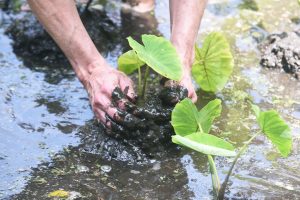Although the last day of any experience is often bittersweet, our potluck dessert table made…
Daily Manaʻo for Cohort Kumukahi March 2024 – Tuesday
Tuesday, March 19, 2024
With the sun rising above the ridgeline of the Koʻolau mountains, we greeted the warmth of the day with the moʻolelo of Hāloanakalaukapalili. By outlining the moʻokūʻauhau of Hāloa, we also gathered a deeper appreciation for the many lineages that shape how we interact with the ʻāina as our kaikuaʻana. In this moʻolelo, we honor Papahānaumoku and Wākea as the grandparents of Hāloa and Hoʻohōkūkalani as Hāloa’s mother. This day, we focused on the familial relationships that guide our individual kuleana to place.
In the midday warm of the sun, we visited Ka Papa Loʻi ʻo Kānewai. Already, we had been acclimating ourselves to the ʻili ʻāina of Kānewai, and the rains and winds that descended down the slopes of Waʻahila ridge became more visible from the view of the loʻi. We listened to the moʻolelo of Kāne and Kanaloa searching for fresh groundwater, and we went to visit the poʻowai, the source of water that feeds the ʻauwai, the interlaced irrigation system that provides fresh running water throughout the loʻi.
Additionally, we honored the fact that we were visiting Kānewai on the day of Ka Piko o Wākea, the spring equinox. Situating ourselves in relation to the celestial movements of our stars and planets is an incredibly important practice, especially as we deepened our roots and understanding of all the ways in which our moʻokūʻauhau are highly relational. As we walked the length of the ʻauwai and hiked all the way to the poʻowai, the source of the waters in the ʻauwai, we were able to become more familiar with the ʻili ʻāina of Kānewai.
Our first steps in the loʻi were to hehi the lepo and oxygenate the earth and nutrients in the individual loʻi. Perhaps there were some whose first steps were tentative as they walked through the darkly colored mud and the swirling surface layer of cold, running water. As our work progressed, we then moved to the loʻi named Puepueilio and helped to puʻepuʻe (remound) the kalo. The act of puʻepuʻe likewise helps to oxygenate the deeper roots of each kalo, and the surface of each mound receives new, nutritious lepo to keep up with the kalo’s upward growth.
In the afternoon, we then transitioned to a “Speed Dating” activity where cohort members were able to participate in one-on-one conversations where they took turns being a listener and a speaker while reflecting on four concepts we have been learning: moʻokūʻauhau, kaikuaʻana, kaikaina, and kuleana. Afterwards, we were able to discuss and debrief our activity together. For one person who shared about their experience, they commented that being a speaker helped them to find a deeper truth, and that each time they said something, it felt more real.
We wrapped up our debrief with a very thought-provoking clarification question on the nature of being kaikaina to the ʻāina. Because we have been learning about the moʻolelo of Hāloanakalaukapalili as the elder sibling to Hāloa, the first kanaka, we discussed how we can be in sibling relationships with our non-human relatives. How are both a new seed and an old tree forms of our kaikuaʻana? How can we be kaikaina to a seed not yet sprouted? A response by another cohort member indicated the importance of epigenetic inheritance and environmental conditions. If moʻokūʻauhau is indeed a highly relational understanding of genealogies, deeper understandings of moʻokūʻauhau invite larger scopes of engaging with our relations. Because a seed is not a standalone organism, because that seed came from generations of ancestors with lifetimes of stories, because that seed represents the potential growth and future of a family—we acknowledge even the littlest of seeds as an ancestor.

